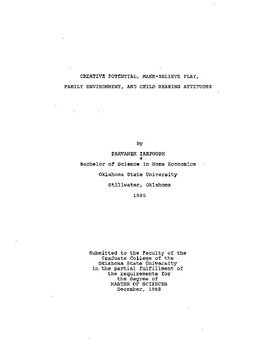| dc.contributor.advisor | Moran, James D., III | |
| dc.contributor.author | Zarpoush, Parvaneh | |
| dc.date.accessioned | 2015-08-19T16:06:56Z | |
| dc.date.available | 2015-08-19T16:06:56Z | |
| dc.date.issued | 1988-12-01 | |
| dc.identifier.uri | https://hdl.handle.net/11244/15752 | |
| dc.description.abstract | This experiment was conducted to determine if there is a relationship among children's make-believe play, children's creative potentials, parental styles of child rearing. The subjects were 27 children with a mean age of 56.29 months. The children were tested individually using the Multidimensional Stimulus Fluency Measure to assess creative potential. Teachers rated the Make-Believe of each child and the parents completed questionnaires assessing a variety of family variables (PARI and FES). The results indicated a significant relationship between two PARI variables (authoritarian, and democratic), and originality. No significant relationships aomong other variables were found. | |
| dc.format | application/pdf | |
| dc.language | en_US | |
| dc.publisher | Oklahoma State University | |
| dc.rights | Copyright is held by the author who has granted the Oklahoma State University Library the non-exclusive right to share this material in its institutional repository. Contact Digital Library Services at lib-dls@okstate.edu or 405-744-9161 for the permission policy on the use, reproduction or distribution of this material. | |
| dc.title | Creative Potential, Make-believe Play, Family Environment, and Child Rearing Attitudes | |
| dc.type | text | |
| dc.contributor.committeeMember | Tweedie, Patricia | |
| dc.contributor.committeeMember | Fournier, David | |
| osu.filename | Thesis-1988-Z38c.pdf | |
| osu.accesstype | Open Access | |
| dc.description.department | Family Relations and Child Development | |
| dc.type.genre | Thesis | |
